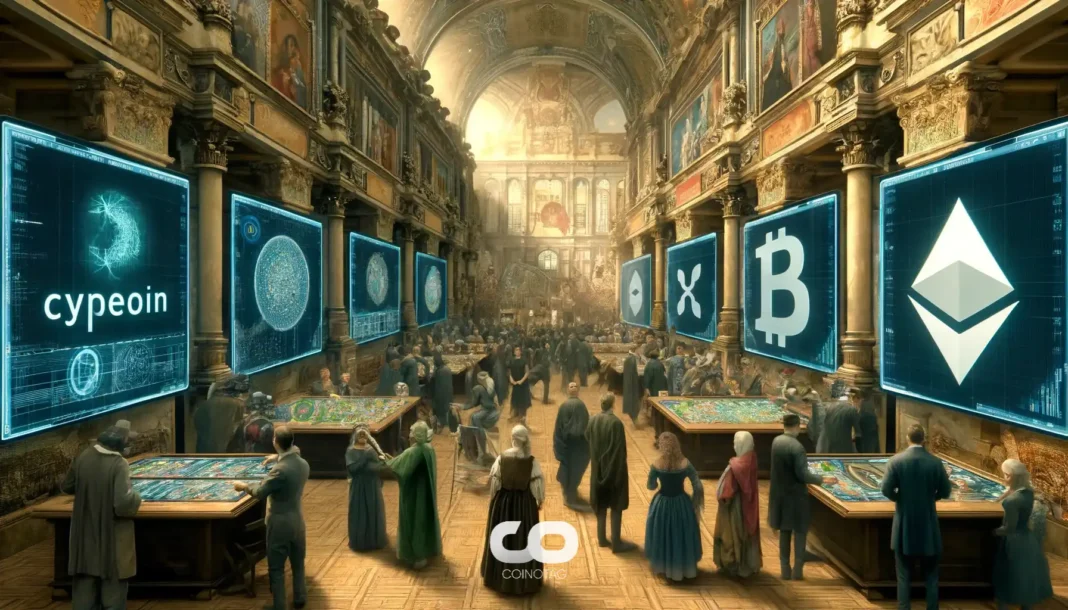| COINOTAG recommends • Exchange signup |
| 💹 Trade with pro tools |
| Fast execution, robust charts, clean risk controls. |
| 👉 Open account → |
| COINOTAG recommends • Exchange signup |
| 🚀 Smooth orders, clear control |
| Advanced order types and market depth in one view. |
| 👉 Create account → |
| COINOTAG recommends • Exchange signup |
| 📈 Clarity in volatile markets |
| Plan entries & exits, manage positions with discipline. |
| 👉 Sign up → |
| COINOTAG recommends • Exchange signup |
| ⚡ Speed, depth, reliability |
| Execute confidently when timing matters. |
| 👉 Open account → |
| COINOTAG recommends • Exchange signup |
| 🧭 A focused workflow for traders |
| Alerts, watchlists, and a repeatable process. |
| 👉 Get started → |
| COINOTAG recommends • Exchange signup |
| ✅ Data‑driven decisions |
| Focus on process—not noise. |
| 👉 Sign up → |
-
Interchain Labs has marked a significant milestone in blockchain interoperability with the introduction of IBC Eureka, bridging Ethereum and Cosmos.
-
This innovative bridge utilizes the enhanced capabilities of the Inter-Blockchain Communication (IBC) protocol to facilitate low-cost, rapid transactions, revolutionizing cross-chain interactions.
-
According to Barry Plunkett, co-CEO of Interchain Labs, “IBC Eureka represents a steep improvement in security and programmability for cross-chain communication,” showcasing the project’s potential.
Interchain Labs’ IBC Eureka bridge innovatively connects Ethereum and Cosmos, enhancing cross-chain communication and reducing transaction costs, redefining DeFi landscape.
Enhancing Blockchain Interoperability: The Launch of IBC Eureka
The launch of IBC Eureka marks a pivotal moment in the realm of blockchain technology, significantly improving the interoperability between two of the industry’s leading networks: Ethereum and Cosmos. This new bridge product leverages the second version of the Inter-Blockchain Communication (IBC) protocol, which allows for seamless connectivity across various blockchain systems. By integrating the robust capabilities of the Cosmos Hub, IBC Eureka enables faster transactions and reduces costs dramatically, with transfer expenses from Ethereum to Cosmos projected to be under $1.
Strategic Implications for Developers and Users
IBC Eureka’s introduction opens numerous avenues for developers aiming to create applications that leverage assets and functionalities across both Ethereum and Cosmos ecosystems. Plunkett emphasized the project’s mission to foster a “truly unified Interchain economy” by expanding its reach to other networks such as Solana, Base, and Arbitrum in the near future. This effort not only simplifies cross-chain operations but also enhances the potential for liquidity and protocol integration that has historically been limited to isolated blockchain environments.
Key Projects Joining the IBC Eureka Ecosystem
Several notable projects have already committed to utilizing the IBC Eureka bridge. Among them are:
| COINOTAG recommends • Professional traders group |
| 💎 Join a professional trading community |
| Work with senior traders, research‑backed setups, and risk‑first frameworks. |
| 👉 Join the group → |
| COINOTAG recommends • Professional traders group |
| 📊 Transparent performance, real process |
| Spot strategies with documented months of triple‑digit runs during strong trends; futures plans use defined R:R and sizing. |
| 👉 Get access → |
| COINOTAG recommends • Professional traders group |
| 🧭 Research → Plan → Execute |
| Daily levels, watchlists, and post‑trade reviews to build consistency. |
| 👉 Join now → |
| COINOTAG recommends • Professional traders group |
| 🛡️ Risk comes first |
| Sizing methods, invalidation rules, and R‑multiples baked into every plan. |
| 👉 Start today → |
| COINOTAG recommends • Professional traders group |
| 🧠 Learn the “why” behind each trade |
| Live breakdowns, playbooks, and framework‑first education. |
| 👉 Join the group → |
| COINOTAG recommends • Professional traders group |
| 🚀 Insider • APEX • INNER CIRCLE |
| Choose the depth you need—tools, coaching, and member rooms. |
| 👉 Explore tiers → |
- dYdX, a decentralized exchange looking to expand its trading functionalities;
- MANTRA, which focuses on real-world asset management via Layer 1 blockchain;
- Lombard, a Bitcoin liquid staking protocol, and;
- Babylon, a protocol enhancing Bitcoin staking.
Fisher Yu, CTO of Babylon Labs, remarked that the integration of Bitcoin Staking LSTs through IBC Eureka represents a significant leap toward unlocking Bitcoin’s full decentralized finance (DeFi) potential. He noted that, “This integration enables seamless, secure, and efficient access to Cosmos DeFi for Bitcoin holders.”
The Role of the Interchain Foundation in Development
Interchain Labs operates under the auspices of the Interchain Foundation, a nonprofit entity based in Switzerland dedicated to fostering the growth of the Cosmos ecosystem. The launch of IBC Eureka follows a successful testing phase conducted earlier this year, where the operability between Ethereum and Cosmos was validated. Such groundwork ensures that the exchange of assets and data between these platforms is not only feasible but also secure and efficient.
| COINOTAG recommends • Exchange signup |
| 📈 Clear interface, precise orders |
| Sharp entries & exits with actionable alerts. |
| 👉 Create free account → |
| COINOTAG recommends • Exchange signup |
| 🧠 Smarter tools. Better decisions. |
| Depth analytics and risk features in one view. |
| 👉 Sign up → |
| COINOTAG recommends • Exchange signup |
| 🎯 Take control of entries & exits |
| Set alerts, define stops, execute consistently. |
| 👉 Open account → |
| COINOTAG recommends • Exchange signup |
| 🛠️ From idea to execution |
| Turn setups into plans with practical order types. |
| 👉 Join now → |
| COINOTAG recommends • Exchange signup |
| 📋 Trade your plan |
| Watchlists and routing that support focus. |
| 👉 Get started → |
| COINOTAG recommends • Exchange signup |
| 📊 Precision without the noise |
| Data‑first workflows for active traders. |
| 👉 Sign up → |
Future Outlook for Cross-Chain Solutions
The advancements represented by IBC Eureka could be a game-changer for the future of decentralized finance and blockchain interoperability. As more projects adopt this bridge technology, it will likely lead to a more cohesive ecosystem where assets can flow freely across chains. Developers will have the tools to create innovative solutions that merge functionalities from different platforms, enhancing the user experience and operational efficiency.
Conclusion
In summary, the IBC Eureka bridge exemplifies the growing trend toward enhanced blockchain interoperability, allowing Ethereum and Cosmos to foster new applications and DeFi solutions. As this technology continues to develop and expand its outreach to include more blockchain networks, it holds the promise of creating a dynamically interconnected blockchain ecosystem. The clarity and efficiency provided by such cross-chain solutions will undoubtedly shape the future landscape of decentralized finance.
| COINOTAG recommends • Traders club |
| ⚡ Futures with discipline |
| Defined R:R, pre‑set invalidation, execution checklists. |
| 👉 Join the club → |
| COINOTAG recommends • Traders club |
| 🎯 Spot strategies that compound |
| Momentum & accumulation frameworks managed with clear risk. |
| 👉 Get access → |
| COINOTAG recommends • Traders club |
| 🏛️ APEX tier for serious traders |
| Deep dives, analyst Q&A, and accountability sprints. |
| 👉 Explore APEX → |
| COINOTAG recommends • Traders club |
| 📈 Real‑time market structure |
| Key levels, liquidity zones, and actionable context. |
| 👉 Join now → |
| COINOTAG recommends • Traders club |
| 🔔 Smart alerts, not noise |
| Context‑rich notifications tied to plans and risk—never hype. |
| 👉 Get access → |
| COINOTAG recommends • Traders club |
| 🤝 Peer review & coaching |
| Hands‑on feedback that sharpens execution and risk control. |
| 👉 Join the club → |
| COINOTAG recommends • Members‑only research |
| 📌 Curated setups, clearly explained |
| Entry, invalidation, targets, and R:R defined before execution. |
| 👉 Get access → |
| COINOTAG recommends • Members‑only research |
| 🧠 Data‑led decision making |
| Technical + flow + context synthesized into actionable plans. |
| 👉 Join now → |
| COINOTAG recommends • Members‑only research |
| 🧱 Consistency over hype |
| Repeatable rules, realistic expectations, and a calmer mindset. |
| 👉 Get access → |
| COINOTAG recommends • Members‑only research |
| 🕒 Patience is an edge |
| Wait for confirmation and manage risk with checklists. |
| 👉 Join now → |
| COINOTAG recommends • Members‑only research |
| 💼 Professional mentorship |
| Guidance from seasoned traders and structured feedback loops. |
| 👉 Get access → |
| COINOTAG recommends • Members‑only research |
| 🧮 Track • Review • Improve |
| Documented PnL tracking and post‑mortems to accelerate learning. |
| 👉 Join now → |







